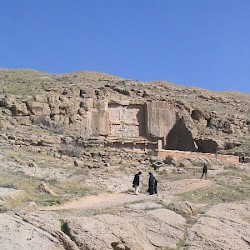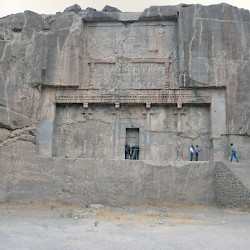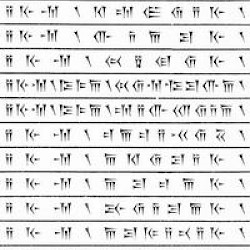Achaemenid Royal Inscriptions: collection of Old Persian cuneiform texts from the sixth, fifth, and fourth centuries BCE, left by the Achaemenid kings on their official monuments.
 Persepolis, Tomb of Artaxerxes II Mnemon
|
 Persepolis, Tomb of Artaxerxes II Mnemon
|
 A2Pa (drawing)
|
|
- iyam \ Pârsâ
- iyam \ Mâda
- iyam \ Uvja
- iyam \ Parthava
- [iyam \ Haraiva
- iyam \ Baxtriya
- iyam \ Suguda]
- iyam \ Uvârazmiya
- iyam \ Zrakâ
- iyam \ Harauvatiya
- iyam \ Thataguiya
- iyam \ Gadâraya
- iyam \ Hiduya
- iyam \ Sakâ \ haumavargâ
- iyam \ Sakâ \ tigraxaudâ
- iyam \ Bâbiruš
- iyam \ Athuriya
- iyam \ Arabâya
- iyam \ Mudrâya
- iyam \ Arminiya
- iyam \ Katpatuka
- imay \ Spardiya
- iyam \ Yaunâ
- iyam \ Sakâ \ paradraiya
- iyam \ Skudra
- iyam \ Yauna \ takabarâ
- iyam \ Putâya
- iyam \ Kušâya
- iyam \ Maciya
- iyam \ Karka
|
- This is the Persian.
- This is the Mede.
- This is the Elamite.
- This is the Parthian.
- [This is the Arian.
- This is the Bactrian.
- This is the Sogdian.]
- This is the Chorasmian.
- This is the Drangian.
- This is the Arachosian.
- This is the Sattagydian.
- This is the Gandaran.
- This is the man of Sind.
- This is the haoma-drinking Saca.
- This is the Saca with the pointed hat.
- This is the Babylonian.
- This is the Syrian.
- This is the Arab.
- This is the Egyptian.
- This is the Armenian.
- This is the Cappadocian.
- This is the Lydian.
- This is the Greek.
- This is the Scythian from across the sea.
- This is the Thracian.
- This is the Macedonian.
- This is the Libyan.
- This is the Nubian.
- This is the man of Maka.
- This is the Carian.
|
Literature
- Pierre Lecoq, Les inscriptions de la Perse achéménide (1997 Paris)


